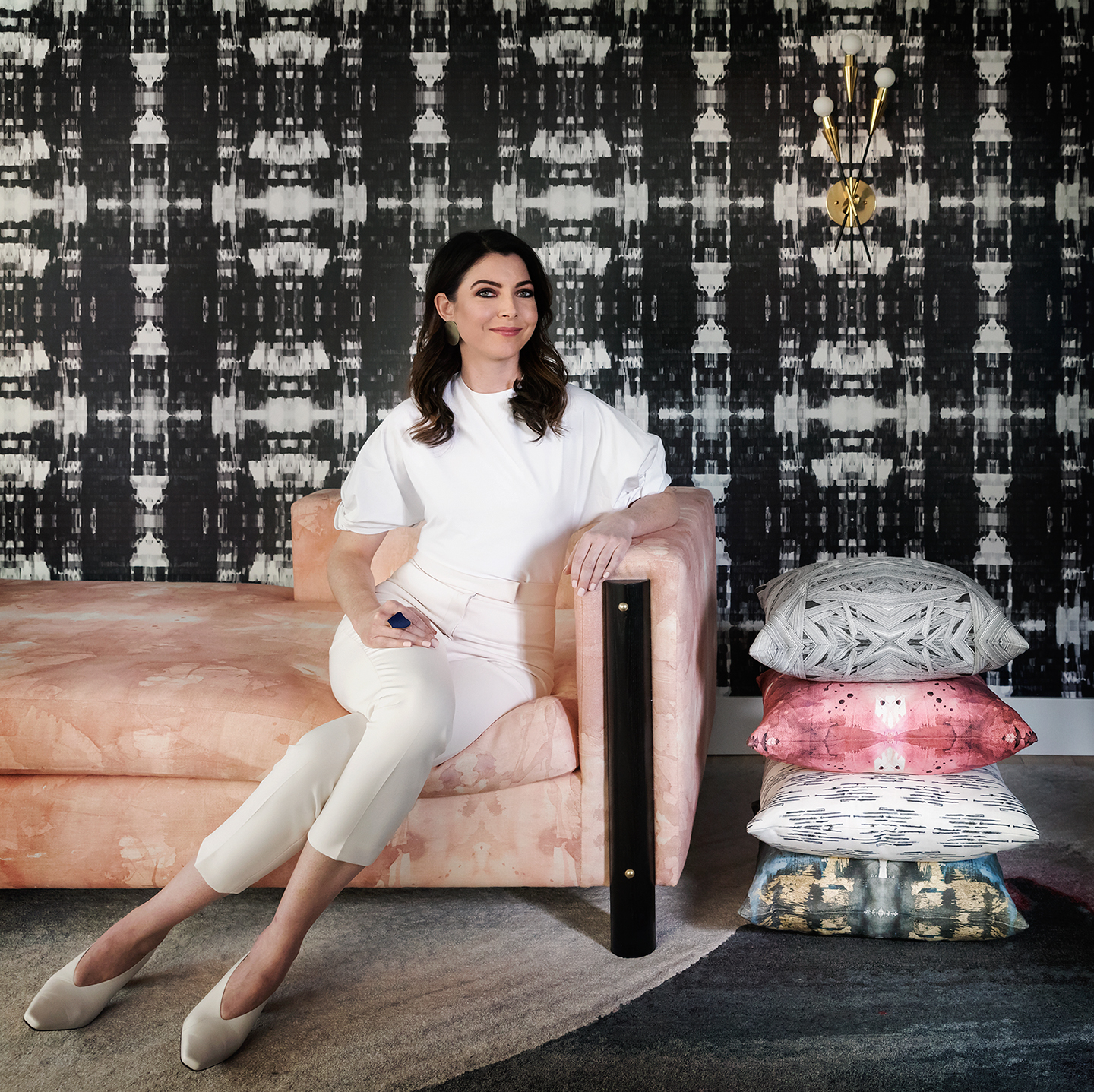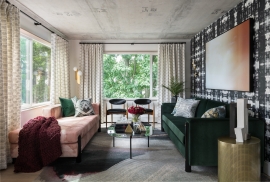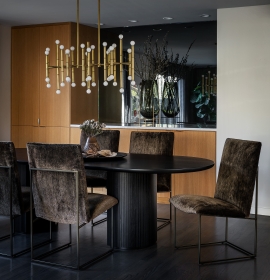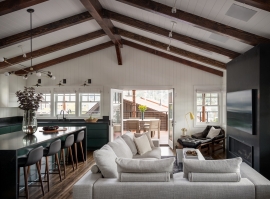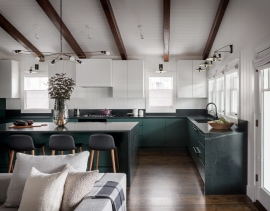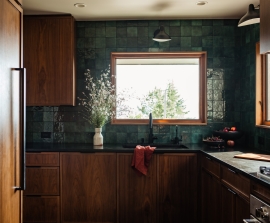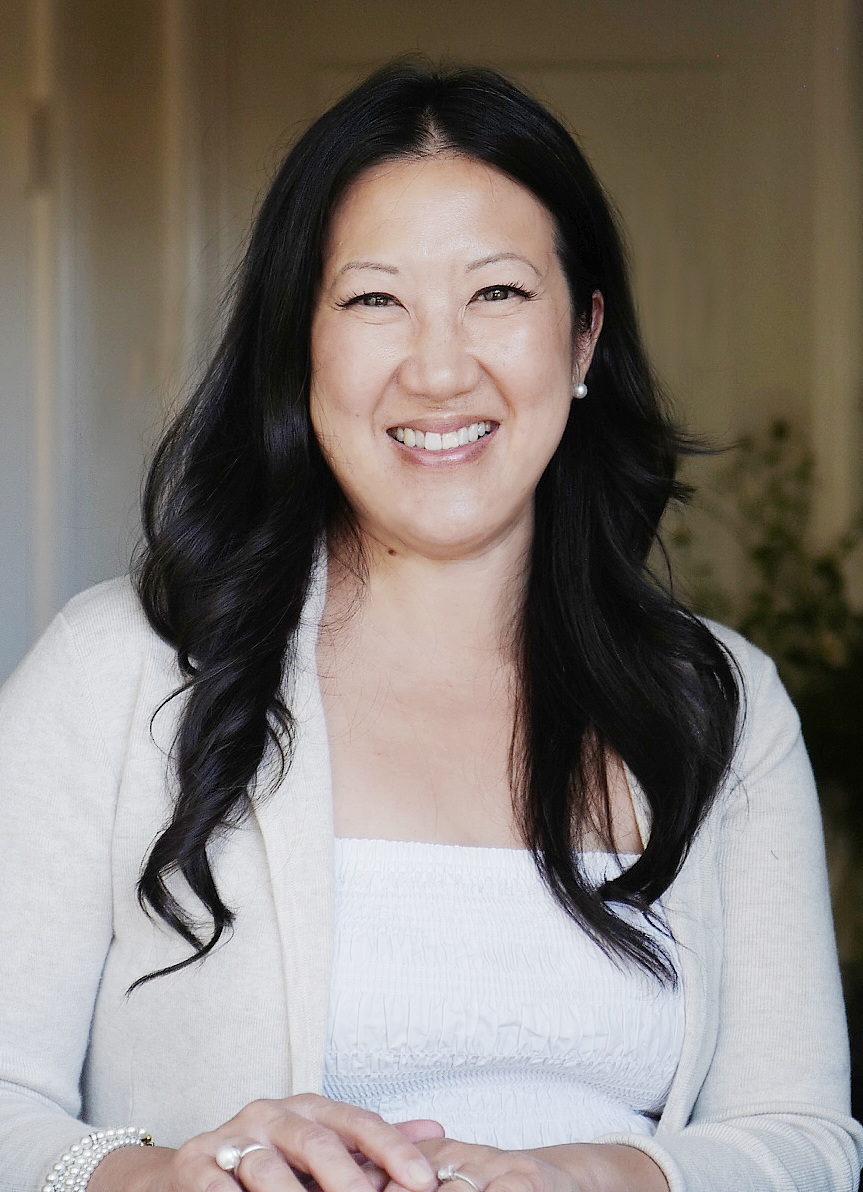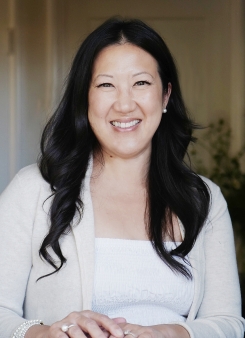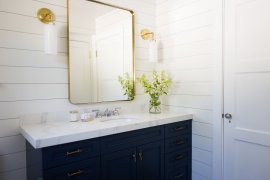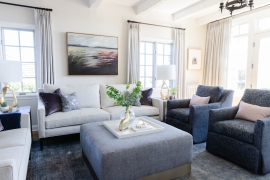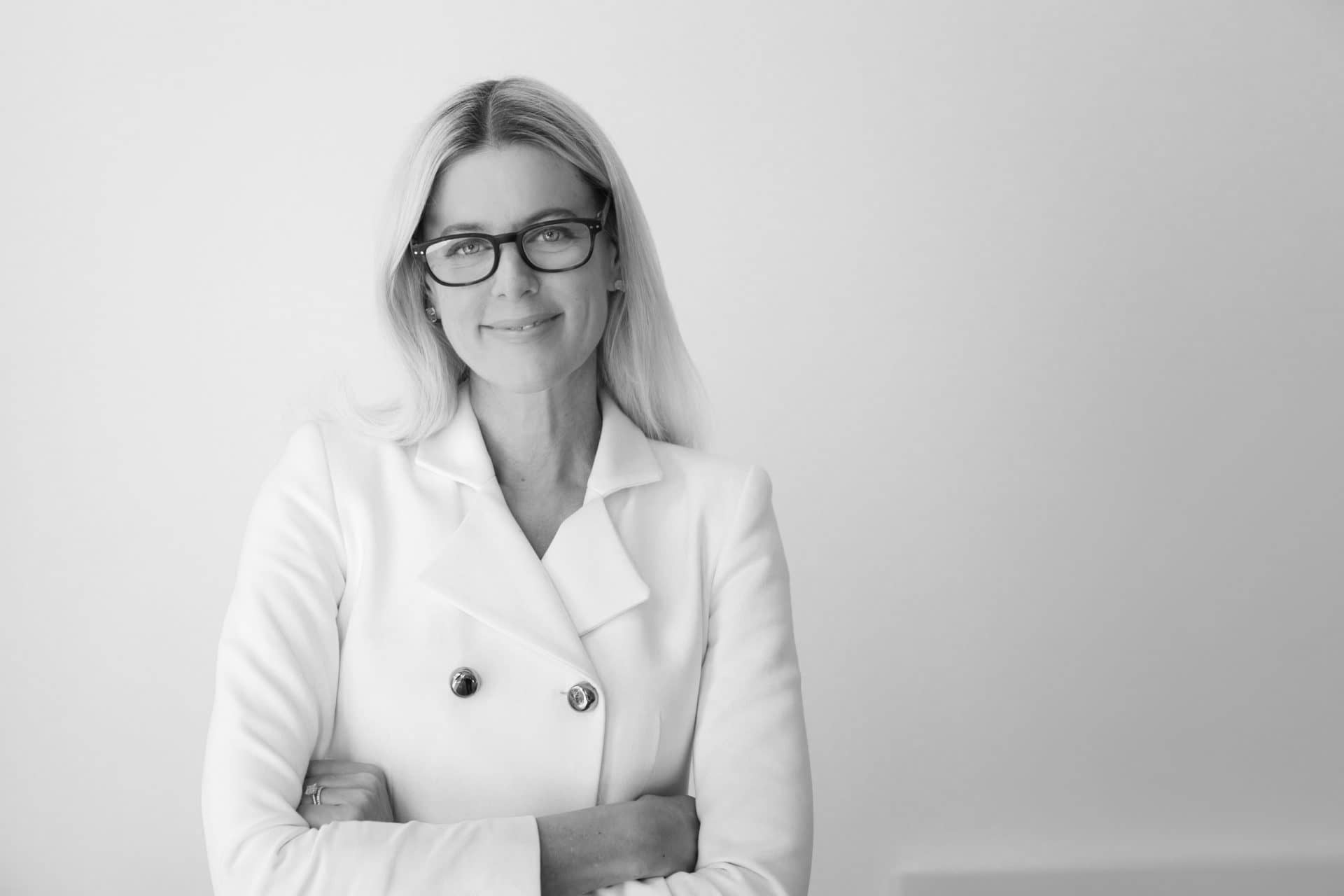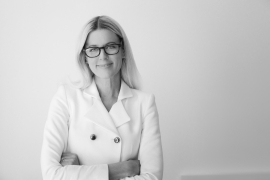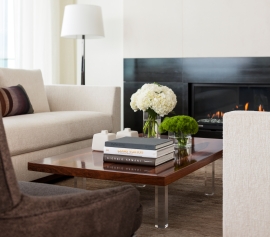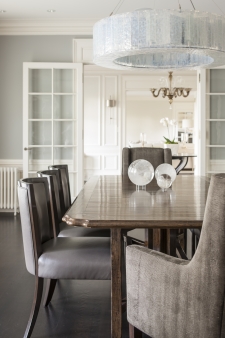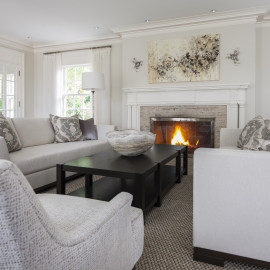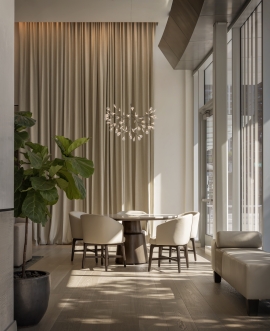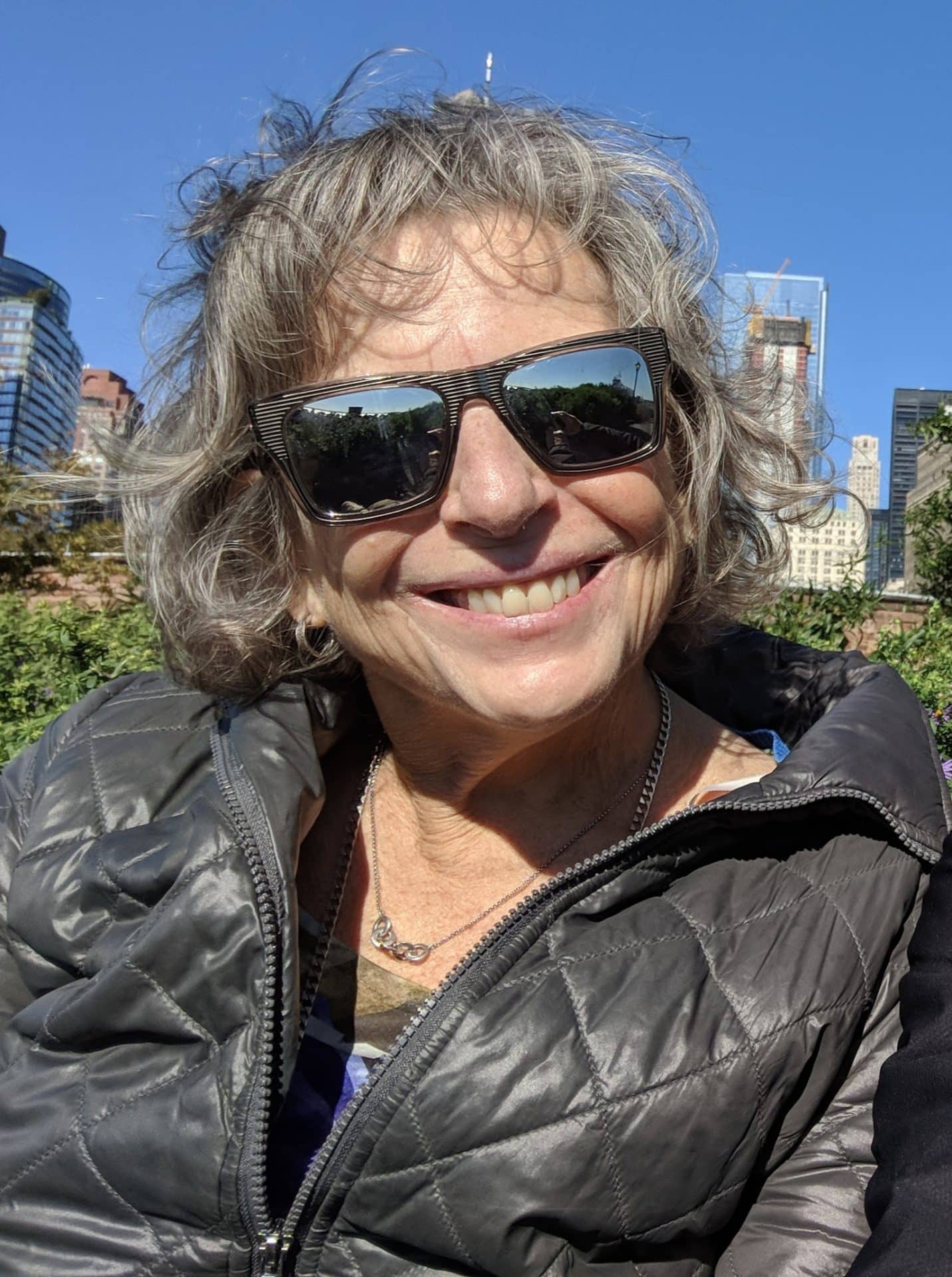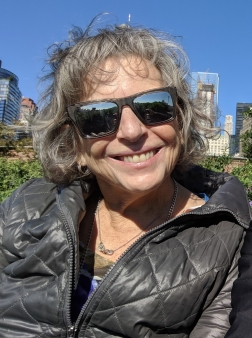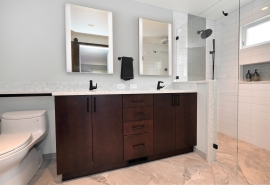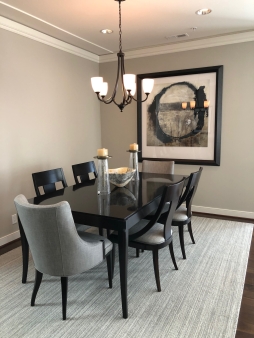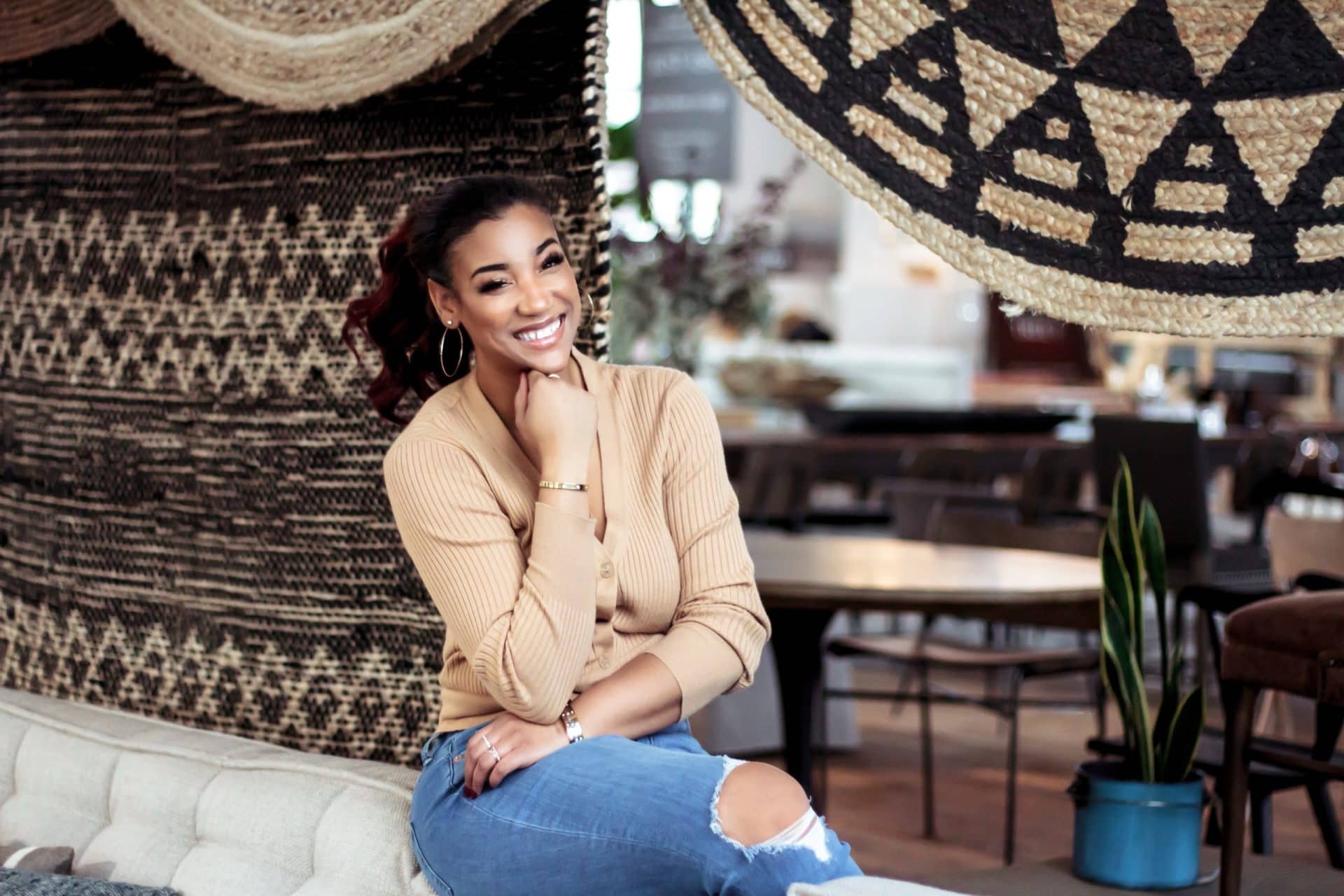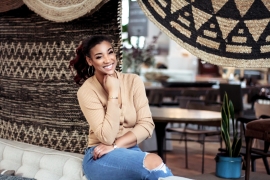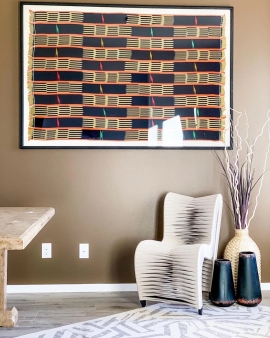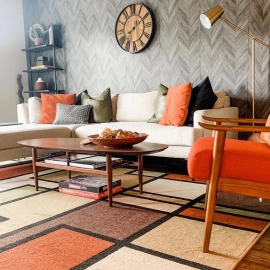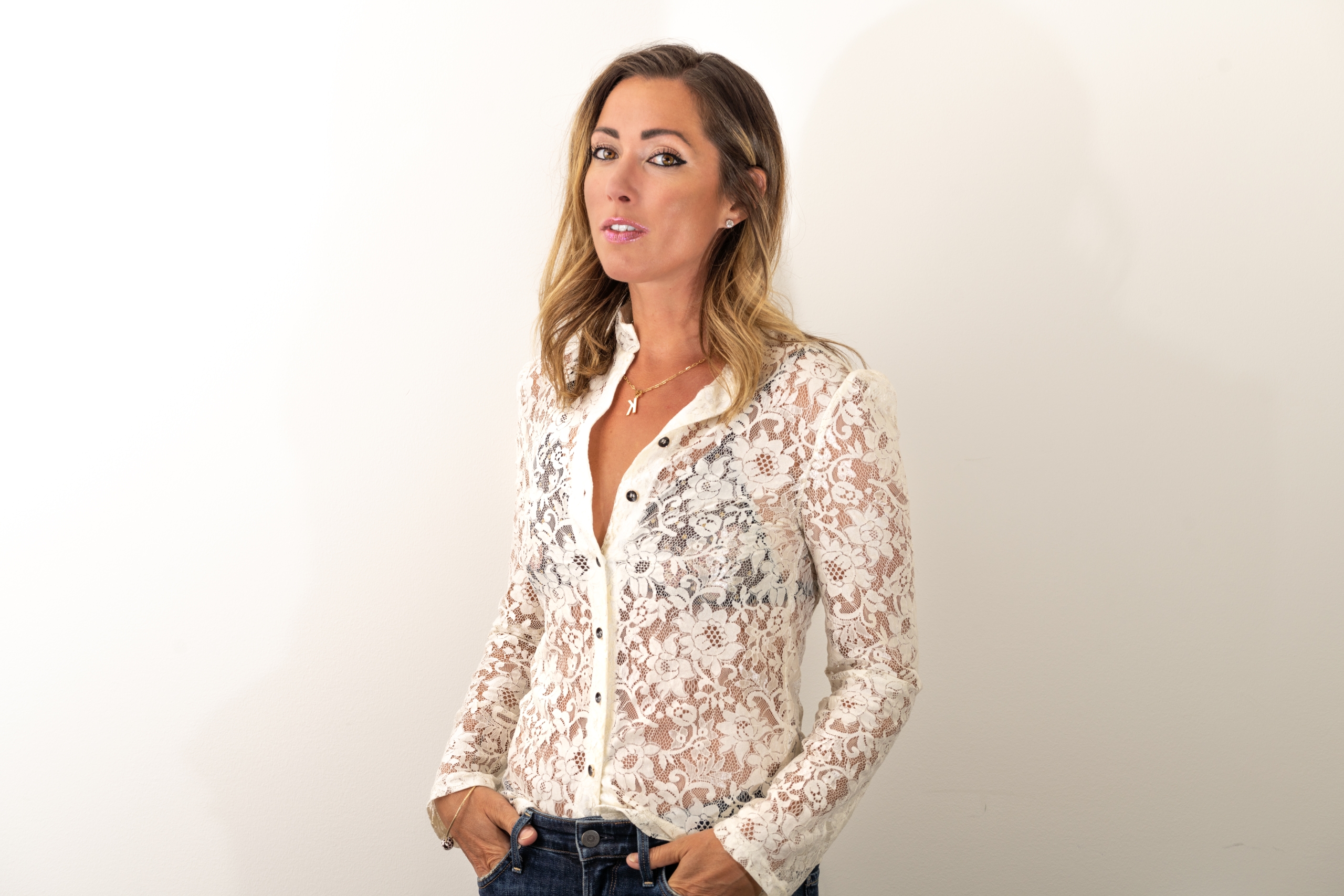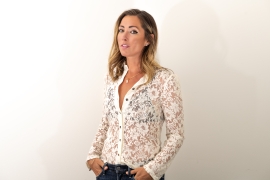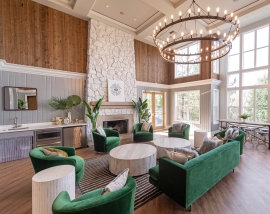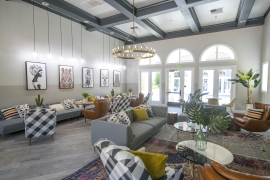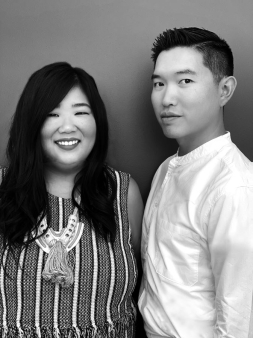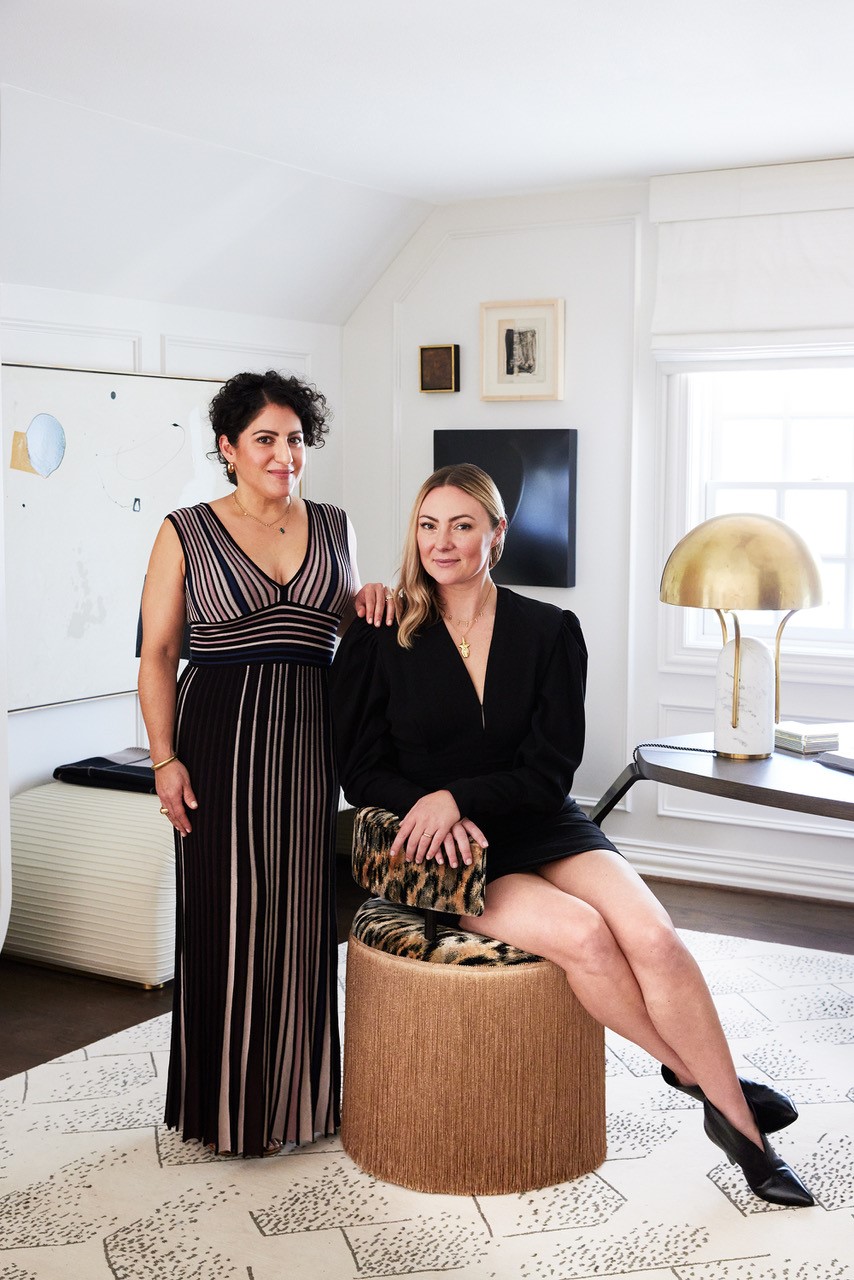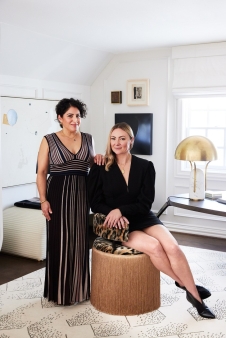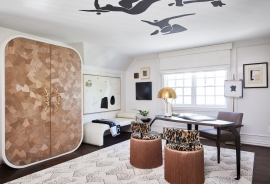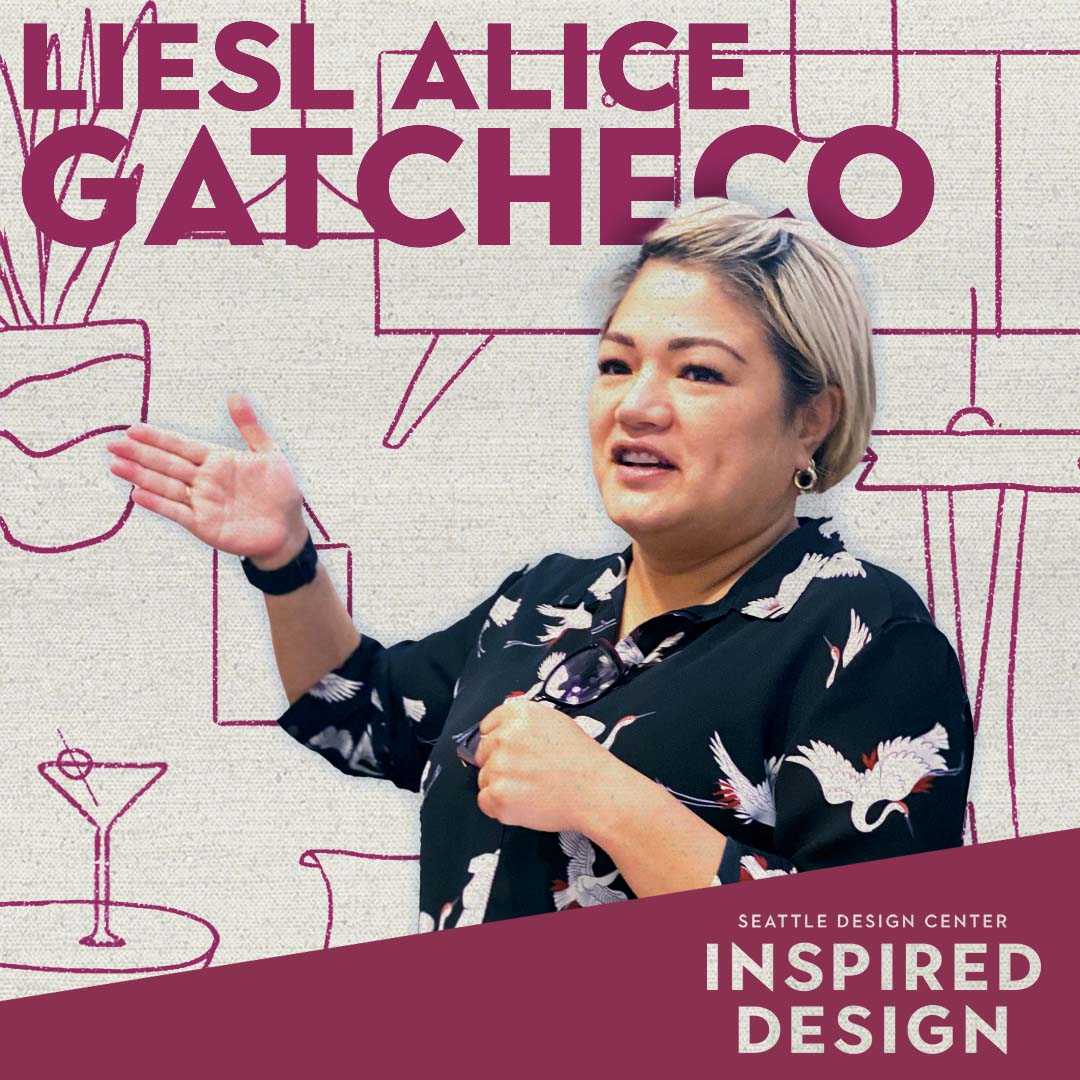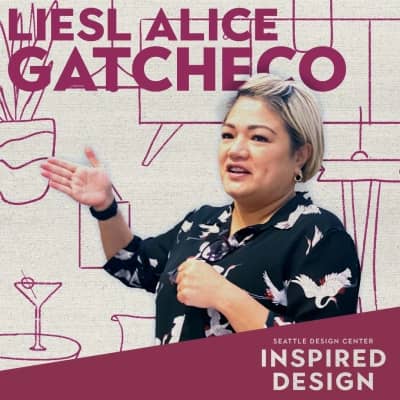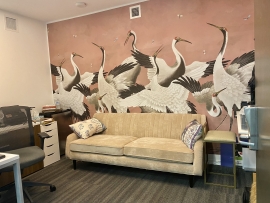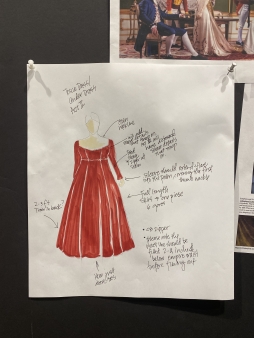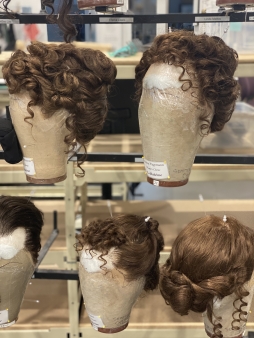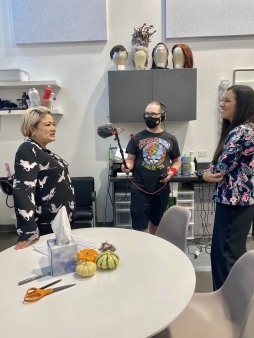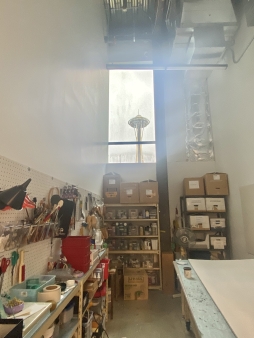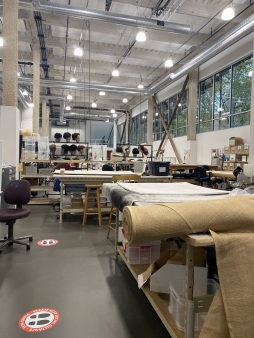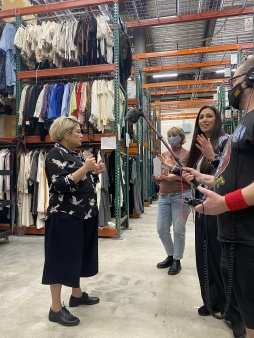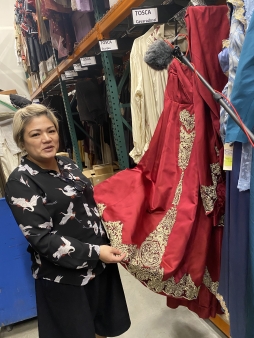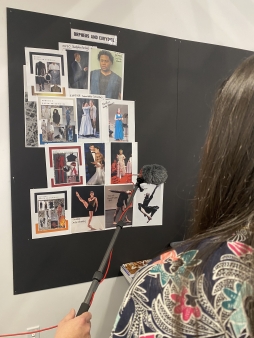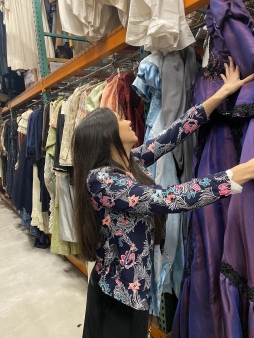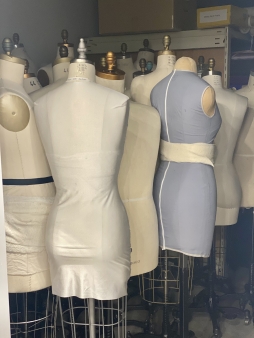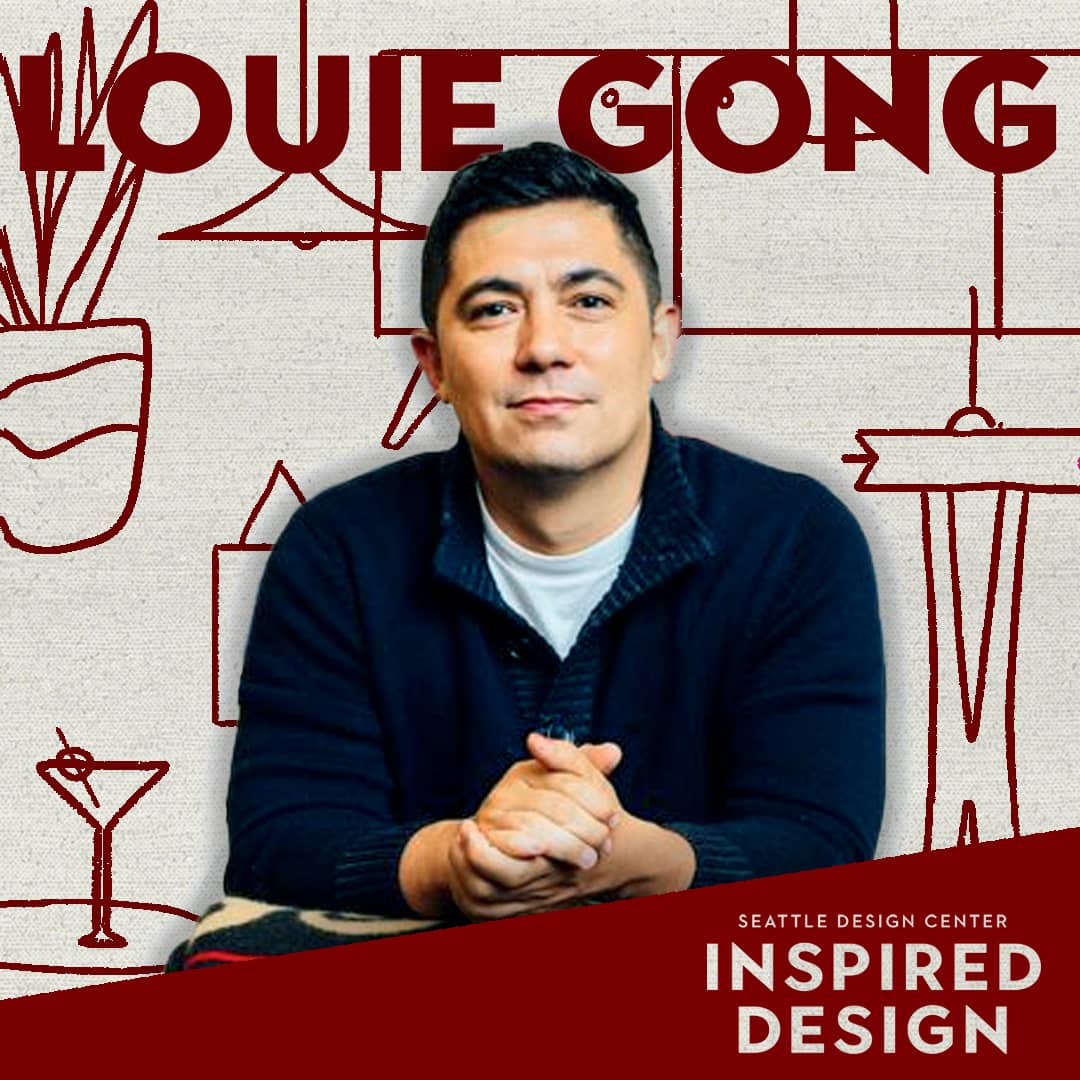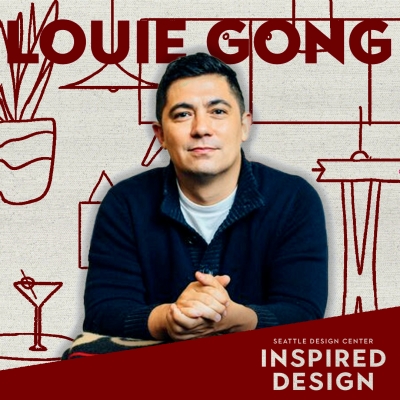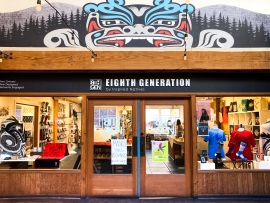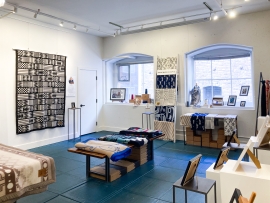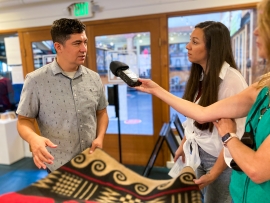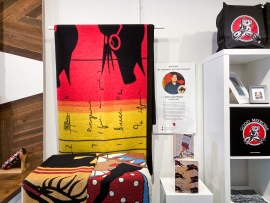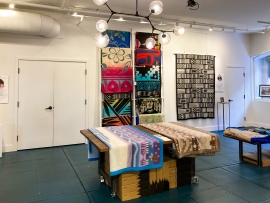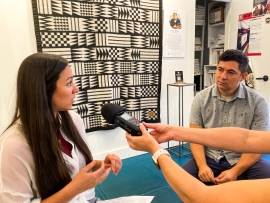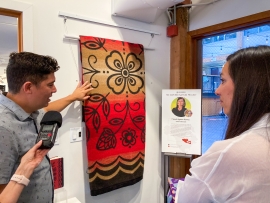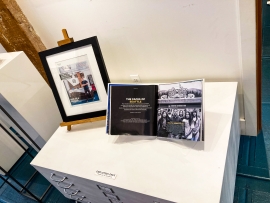Episode Transcript
Louie Gong:
As a kid being raised by Grandma and Grandpa, I was first raised in a house with no running water, and we were very poor, but that doesn’t tell the whole story of how I grew up, because I always had a dad who was very good at a few different things. And one of them was the martial arts.
Gina Colucci:
I’m Gina Colucci, with the Seattle Design Center. Every week on Inspired Design, we sit down with an iconic creator, in a space that inspires them.
Gina Colucci:
Louie Gong is a native artist, educator and public speaker who was raised by his grandparents in the Nooksack tribal community. Louie is also Chinese, French and Scottish
Louie Gong:
Imagine five-year-old Louie sitting on a stool in the corner of a boxing ring, crying, and my dad putting his hand on my shoulder and saying, “If you want to be successful, you have to have the courage to try, over and over again,” and then sending me back out when the bell ring, to get beat up by a much bigger kid.
Gina Colucci:
A self-taught artist, Louie began making art in 2008. After working as an activist for several years, he picked up a pair of plain Van sneakers and started drawing Native designs on them.
Louie Gong:
Nothing reflected who I was. So when I sort of settled for a plain gray pair, I knew that I was going to grab a Sharpie and draw on them.
Gina Colucci:
He started a company, Eighth Generation, with the mission of making cultural art sustainable. As you’ll hear in our conversation, Louie has been wildly successful. Eighth Gen is the fastest growing Native company in North America.
Louie Gong:
Taking that leap of faith to invest in myself was a magical moment that I hope other people can experience, as well. But what I would share to the people who have made this move, and not been successful in their first try, is that my journey, which looks like instant success from a distance, if you look a little closer, is composed of a thousand failures.
Gina Colucci:
When I caught up with Louie, we talked art, identity, and how he’s breaking down old stereotypes of modern Native people.
Louie Gong:
Well, you guys are up here on a really good day, because today is, I think, the four-year anniversary of when me and a friend of Eighth Generation named Bob, and our intern, Sequoia, stayed up till 2:00 a.m., working on the point of sale.
Louie Gong:
I know that, because social media just told me that it was the anniversary. I looked at this video of a much younger-faced Louie, with a Shop-Vac, vacuum up all the sawdust, after putting the point of sale together.
Louie Gong:
Yeah, so we have this, a cash register point of sale, that is also a nice display at the store. What it embodies, I think, is the Eighth Generation spirit, because when we opened the store, we did not have a big budget.
Louie Gong:
The cabinets here are from IKEA, and the countertop is from Urban Reclamations, which is a local business, and a local artist did the geometric woodwork that’s on the front. But the installation happened the day before the store opened, with these two hands right here, with sweat on my brow.
Louie Gong:
Here at two o’clock in the morning with friends and family embodies, not just the Eighth Generation spirit, but my own journey as an artist. There’s been a lot of elbow grease.
Gina Colucci:
Yeah.
Louie Gong:
The name Eighth Generation is based on the inter-tribal value of seven generations. To describe it in a rudimentary way, it’s basically just a decision making framework that says that you should consider the consequences of your decisions, seven generations into the future.
Louie Gong:
By naming the business Eighth Generation, I’m paying respect to everybody that came before me. When I think about the possibilities of having a new phase of creative work that affects cultural change, in an even greater way than Eighth Generation has, I get really excited, because I know that’s the next collaboration with my grandma and grandpa, and my dad, and the other people that supported me along my journey.
Gina Colucci:
Why and what was it like deciding to open your storefront, here at Pike Place Market?
Louie Gong:
At Eighth Gen, we pursue multiple types of currencies. It’s not just all about making money. We also want to control the story about Native people, and we want to create opportunities for Native artists.
Louie Gong:
Being at Pike Place Market was really attractive to us, because we knew we could reach thousands of people a day, from all over the world, but also that it was a great place to do business. People were interested in experiencing Native art when they visit Pike Place Market.
Louie Gong:
So this was a space that sort of checked all the boxes for us. For me personally, I definitely have a strong activist streak, so I only get interested in the idea if it’s disrupting something. Being the only Native-owned store at Pike Place Market, and the only one downtown at that time was very attractive to me.
Louie Gong:
We wanted to shake things up, have a strong presence here. We have neon signs out here and also a sign on the front of our store, that’s 25 feet long.
Louie Gong:
To get any of those in place, it took years of work, that has totally happened, in a way that is invisible to most people who will visit the store. I mean, for me personally, I embraced that grind, but sometimes I need to tell the story into a mic, so people know.
Gina Colucci:
Yeah.
Louie Gong:
[crosstalk 00:06:09] Because people will say, people will think that the store was handed to you, or that the signs were handed to you. As a Native-owned business, we get a lot of weird ideas projected onto us, by people who walk in the store.
Louie Gong:
People think that we’re a nonprofit, because they look at the capacity that is represented by what they see in the store. And they think that Native people could never get to that space, unless they were sponsored in some way.
Louie Gong:
That, of course, is not the case. The business has never even had a business loan. Of course, we’re owned by the Snoqualmie tribe now, which is very exciting, and makes us feel super optimistic about the business’s ability to grow times a hundred into the future.
Louie Gong:
They’ll also come into the store, and assume that everything in the store is handmade, because Native people can’t work with manufacturers, like everybody else can. For it to be “Native,” I’m making air quotes, officially, it needs to be handmade by your aunties and grandmas in the back room.
Louie Gong:
Some people are really disappointed, when what we tell them doesn’t reinforce the stereotypes that they have when they walk into the store, and they turn around and walk out. But that’s okay with us, because even though they didn’t buy anything, they’re leaving with something which is really important. And that’s accurate information about contemporary Native people.
Gina Colucci:
One other question I kind of wanted to touch on, I know you have phone cases, you have socks, you have cards here, jewelry, but you see very modern items with your traditional art on it.
Louie Gong:
Yeah. People always come in here, and they say, “Where’s the flute music? And how come you don’t have any one-off carvings for sale?” They want that one-off art piece when they think of Indigenous art, because that’s what they associate with Indigenous art.
Louie Gong:
Here at Eighth Gen, we have exclusively created products, and a lot of them for very contemporary objects, like phone cases. We do that, because we actively try to push against stereotypes, and the resistance that we get to just exercise in our natural way of being.
Louie Gong:
As a Native person, I use a phone case and I wear socks. So the idea that our own artwork shouldn’t be on those objects is totally false. It is the internalization of these anthropological ideals that are frozen in time, like at first contact.
Louie Gong:
I started to recognize that, “Hey, our ancestors always put art on things that they use.” There’s absolutely nothing wrong with putting our art on utilitarian objects.
Louie Gong:
I started off, by the way, drawing on shoes, and moccasins were custom footwear. People were surprised and said that what I was doing was very contemporary, but it wasn’t at all. It was actually traditional.
Gina Colucci:
What was going through your mind when you were drawing your first pair of Vans?
Louie Gong:
It stemmed from frustration. I went to the Vans store, and I looked up on the shelf, and there was no designs up there that really reflected who I wad. There were skulls and checker boards, but nothing reflected who I was.
Louie Gong:
So when I sort of settled for a plain gray pair, I knew that I was going to grab a Sharpie and draw on them. And I didn’t know what it would be, but I knew it needed to reflect me.
Louie Gong:
And a few months later, I didn’t do it right away, I took at that Sharpie, and I drew a very simple Coast Salish paw pattern on the shoes. And it wasn’t very good.
Louie Gong:
I started wearing them when the design was half done, but when people saw them, they were like, “Man, those are sick. Where’d you get those? How can I get a pair?” That was the beginning of Eighth Generation.
Louie Gong:
I knew that they liked it, not because the art was spectacular, it was because the idea was resonating with their lived experience. And I think that you see me following that initial spark in almost everything that Eighth Generation does.
Gina Colucci:
That’s great. And why did you do the paw prints?
Louie Gong:
I did the paw prints on the shoes, because the shoes go in your feet. I thought having paws on a pair of classic slip on Vans made perfect sense, but also, the shape of the design matched the shape of the shoe.
Gina Colucci:
That makes me think, I was actually just on your Instagram page, and you created this box, and each corner is a different …
Speaker 3:
Yeah, it’s a guardian.
Speaker 4:
Guardian.
Louie Gong:
Yeah.
Gina Colucci:
That’s right, yeah. It was fascinating to see that it was perfectly each one melded into the other, if I’m getting this correct. So each corner is a different profile point of view of your guides.
Louie Gong:
Yeah. The Guardians Bent Wood Box, which is a collaboration with my uncle, Peter Gong. He makes the boxes, and I often put art on them.
Louie Gong:
The Guardians box that we’re talking about was actually a gift that was commissioned by the city of Seattle, and gifted to the President of China, back in 2015. So I put my guardians design on it, which is a Chinese Fu dog, designed with Northwest Native design elements on it.
Louie Gong:
But it’s a good example of how I think very purposefully about the space that I’m putting the art on, and the purpose of the product or the object that the art is going on, as well. In this case, I wanted something to represent protection, so that you could put something important on the box, and the way the Guardian’s design is composed on the box, it represents sort of protections for each direction.
Gina Colucci:
That’s really, really beautiful. Actually I wanted to know, because …
Louie Gong:
That was my first box that I ever painted.
Gina Colucci:
Really?
Louie Gong:
Yeah, it was my first box that I ever painted. I had no idea what I was doing, and it was all very last minute too. So I had two days to make something for the President of China, and …
Gina Colucci:
No pressure.
Louie Gong:
Yeah, no big deal. But I already had the box in hand, so I got to work and finished it at the eleventh hour.
Louie Gong:
The last step in the process was to put a coat of notoriously slow drawing walnut oil on the box. It just brought out the color of the wood, and made it super beautiful.
Louie Gong:
But I wasn’t able to see what it looked like completely dry. When I stuck it in the box to give to the Mayor, who was going to give it to the President of China, and what I know is that when that then dry box was pulled from its packaging, to gift to the president of China, it had a perfectly visible thumbprint from my thumb on the top of it.
Gina Colucci:
So now they have your fingerprints.
Louie Gong:
Now they have the fingerprints, and I have an important lesson about what not to do, at the very last minute, before giving an important gift.
Gina Colucci:
Sorry.
Speaker 3:
Yeah.
Announcer:
Seattle Design Center is the premier marketplace for fine home furnishings, designer, textiles, bespoke lighting, curated art, and custom kitchen and bath solutions. We are located in the heart of Georgetown, open to the public Monday through Friday, with complimentary parking.
Announcer:
Our showroom associates are industry experts known for their customer service. We are celebrating new showrooms and added onsite amenities. Visit seattledesigncenter.com for more information about our showrooms, and our find a designer program.
Gina Colucci:
I’m just so curious about everything around me. Do you want to, I guess, talk about the drum that’s up here?
Louie Gong:
Oh, sure. So this drum up here, we’re really proud of. It’s not a ceremonial drum. It was a drum that was gifted to Eighth Generation by the National Center for American Indian Enterprise Development.
Louie Gong:
It’s a national organization, and they recognized us in Vegas, in this grand showcase, because of our work on behalf of Indigenous artists. Receiving that award as an Indigenous artist myself makes me really proud.
Gina Colucci:
What a cool moment. Can you just describe to me, because I don’t know, what’s the difference between this drum and the ceremonial drum?
Louie Gong:
Well, if we had anything that was ceremonial, it wouldn’t be in the store. So one of the reasons why buying from a Native company or a Native artist is important, is because we vet what we bring to market before you ever see it. If you want to make sure that you’re not culturally appropriating or holding something that is not appropriate for you to have, then make sure you are purchasing the things that you’re interested in from Indigenous artists, or Indigenous businesses.
Gina Colucci:
Do you want to tell us about these blankets?
Louie Gong:
Yeah, come over here. This is the first blanket we ever produced. Eighth Generation is the first Native-owned company to produce wool blankets. As an entrepreneur, I didn’t have any business knowledge, and I didn’t have any money.
Louie Gong:
So getting to the point where I can produce a wool blanket with my art on, was not only a first for the Native community, but man, it was a whole collection of first for me in my development. Anyway, the first blanket we produced is this Thunderbird design.
Louie Gong:
The Thunderbird design is mine, but on the ends of it, you’ll see some Maori waves. They’re here on this blanket, because it was a collaboration with our friends at the Evergreen Longhouse.
Louie Gong:
They have a really strong relationship with the Maori, and often do cultural exchanges. So we wanted this to represent that sort of intersection or exchange of cultural knowledge between the Maori and Coast Salish communities.
Gina Colucci:
What made you choose the Thunderbird personally?
Louie Gong:
One of the things that I enjoy as a artist is taking a client’s vision and bringing it to life. It sort of gets filtered through my interests and my experience, and something totally new is created.
Louie Gong:
What you see here is a giant Thunderbird on a bright red blanket, and it’s reminiscent of the giant Thunderbird that’s on the very front of the Evergreen Longhouse. In this way, we’re honoring that physical space that they created, but the artwork in itself is totally unique to me.
Louie Gong:
I think that there are a lot of ways that Native values and traditions have been sort of siloed all under one category, in this sort of pan-Indian idea, and been sold to consumers for hundreds of years. One thing that Eighth Generation is doing, by talking about all the different regions and the difference between artists, by making sure that people know the values of our company, and how they might be different from values of a company that’s on another side of the country, we’re unpacking all that stuff that this broad base of consumers in this country have absorbed over a lifetime.
Louie Gong:
This idea of spirit animal is one of those things. In some communities, it might be a legitimate belief system, but the way that it is commonly understood in pop culture is not very accurate.
Louie Gong:
So here at Eighth Generation, you’ll never hear us talking about spirit animals. And if you see that on a product description of a product, you better go check to see if that’s a Native-owned business, because it’s probably not.
Louie Gong:
We’re less interested in reaffirming stereotypes, and we don’t care at all if the ’80s music being blasted on the sound system in the store throws you off. Because we like ’80s music.
Speaker 3:
Thanks.
Speaker 6:
And so do I.
Louie Gong:
So we just have transitioned from the main retail side of the store to the gallery space.
Gina Colucci:
What I’m noticing is, you have these amazing displays, that visually show you exactly where the artist is from.
Louie Gong:
Let’s come over here and look at this blanket. It’s called Renewal, by Sarah Agaton Howes. What it displays is the floral that is indicative of the traditional art from her region. So Sarah is a bead work artist, and traditionally in her area, they would put their bead work on black fabric, and that’s why the base of this design is black.
Louie Gong:
The reason why they worked on black fabric is pretty similar to the reason why I say John Pepion, who’s a Blackfeet artist from Montana works on ledger paper. And it is that during the reservation period, Native people had very limited access to resources for art.
Louie Gong:
In Sarah’s community, the only fabric that they had to apply their bead work to were the hand-me-down robes from priests. In John Pepion’s community, the only paper that they had to illustrate on were the scrap ledger papers from the Indian agents who were in that area at the time.
Gina Colucci:
I asked Louie to explain what it means to have that art created from necessity, displayed in a Native gallery, a meeting space.
Louie Gong:
It’s crazy to think that in 2016, when the store opened, it was the only Native store in the entire city of Seattle. And Seattle, of course, is named after a Native person. Our football team has a Native aesthetic in its logo.
Louie Gong:
There are totem poles everywhere, and the Native origins of this region are used in the branding of the city, all over the place. Yet the actual participation of Native people in commerce, for people visiting Seattle, was almost nothing.
Louie Gong:
So us being here is an important symbol of change, because I think, with Eighth Generation reaching the scale that we’ve reached now, we’re the fastest growing Native-owned business in the United States or Canada.
Louie Gong:
The reality is that we’ll never go back to the time when there were no Native stores or artists truly participating in the commerce around people coming to visit Seattle. I believe that we’ve opened the doors for a whole generation of Native artists to understand that what we have done is totally possible.
Gina Colucci:
We grabbed a seat and started to talk more about Louie’s personal journey. Thank you so much for being so open with everything in your store and with Eighth Generation.
Gina Colucci:
But I also want to learn like a little bit more bout you personally. Do you want to tell what it was like growing up for you as a Native person with the Nooksack tribe?
Louie Gong:
You know, growing up as a Native person, living in Nooksack was pretty tricky. Right now, I’m able to exercise my identity in a really bold way. I’m Chinese, Native and white. So it wasn’t like there was one set of cultural MAs and communities to connect with, there were always multiple for me.
Louie Gong:
So it was pretty complicated for a young kid. I can remember looking in the mirror and thinking, “Do I look, am I Chinese? Am I Native?” And not really understanding how I was perceived, because the world around me was giving me different messages.
Louie Gong:
Specifically, I can remember this one time, I think I was about 12 years old, I went to the bank, and I didn’t have my ID.
Louie Gong:
So I looked up at the teller in this very small town of Everson, Washington, where I grew up, and I said, “Come on. Don’t I look like a Gong?”
Louie Gong:
She looked down at me and she said, “No.” So I turned around and left without being able to withdraw any money. But the more lasting impact on me was that, “Oh my God, I don’t look Chinese. What do I look like?”
Louie Gong:
I think I spent a lot of time in my teens and into college, trying to understand how, what I inherited from Grandma and Grandpa who raised me, either matched or didn’t match how I was perceived by the community.
Louie Gong:
What you’re sort of told by society is that those things should be congruent. And for me, there was no congruency. I had always received resistance if I was trying to enter an Asian space, or enter a native space, or enter a white space. There was no place where I felt implicit belonging.
Gina Colucci:
I asked Louie, how did he manage to and navigate different spaces if he never fit in?
Louie Gong:
As a kid being raised by Grandma and Grandpa, I was first raised in a house with no running water, and we were very poor, but that doesn’t tell the whole story of how I grew up, because I always had a dad who was very good at a few different things. And one of them was the martial arts.
Louie Gong:
From the time I was able to walk, my dad would come pick me up, and bring me to the martial arts school, where he taught classes. And my early years are defined by participating in the martial arts, starting off with traditional Kung Fu, and then transitioning to kickboxing.
Louie Gong:
Later, my dad and family would transition into Muay Thai, and then have a school that also had mixed martial arts. To this day, they still have a martial arts school.
Louie Gong:
I guess, as a kid, I learned code switching really quickly. So I would be at home, and it was perfectly normal for me to grab a tin ladle and dip it into a bucket of water. That was where I got my drinking water.
Louie Gong:
But then my dad would take me to a martial arts tournament on the weekend, and there’d be hundreds of people there, and he would enroll me in the division up. As an eight-year-old, I was fighting 12 year olds that are way bigger. I have some great pictures of that.
Louie Gong:
Now, I’m not just unafraid of getting punched in the face. I think being not afraid of being punched in the face comes out in me not being afraid to be courageous with my ideas, or to express them, even when I know there’ll be resistance, but also I’m having grown up poor, and with a fair amount of chaos, I’m quite comfortable with the unknown.
Louie Gong:
So that has been an important tool for me on this entrepreneurial journey. You never quite know what the future holds, but you’re constantly required to take all your resources and go all in, like in a poker game.
Louie Gong:
I did that over and over many times, in order to build Eighth Generation. I think that was possible, because I was not really attached to my poker chips.
Louie Gong:
I know what it’s like to be poor. And frankly, those are one of the most happy times of my life. So to go back to that space was not as scary for me, as it might have been to other people.
Gina Colucci:
Going back to that, I mean, you’re from a multi-generational home, same as myself. How do you think that influenced who you are in your work today?
Louie Gong:
When people tell the story about what it was like to go visit that old home that I grew up in, they say the doors were always open. My dad, who was also raised in that home, brought four friends home after school, and my uncle Ted brought five friends home.
Louie Gong:
My grandpa would cook up a big meal on his Coleman camp stove, and then feed everybody. And I think that this meeting space that’s embedded in the store, that we’re sitting in right now, sort of flows from those origins.
Gina Colucci:
What do you think identity means today? And how has that changed, and what does it mean to you?
Louie Gong:
I think that I got to a point, in my exploration of identity. Well, I think I got to a point where I stopped trying to understand it explicitly, but I know what the ingredients are to supporting healthy identity development. It’s just, I don’t have to monitor where it ends up.
Louie Gong:
For me, identity was so important that in college, I started working with a national organization at the time called Maven. It was a nonprofit whose mission was to raise awareness about mixed heritage people and families.
Louie Gong:
By the time we got into the 2000s, I was volunteering regularly with Maven. Then I became a board member, and I became president of Maven in 2006 or 2007-ish, when Barack Obama was running for the Democratic nomination for President of the United States, and people were really confused about him.
Louie Gong:
“Is he Kenyan? Is he American? Is he black? Is he white? How do we describe his lived experience?” And it was super clear at that time that the country not have the tools for talking about a complex identity.
Louie Gong:
Because I was a leader of an institutional force around that discussion, I got a lot of opportunity to use my experience, growing up with my Chinese grandpa and Native grandma, in a rural farming community, to a national audience. In doing that, I learned a couple powerful lessons.
Louie Gong:
One is that the experiences that I had growing up with my grandma and grandpa on the reservation were not only relevant to the experiences of everybody in the country, they were absolutely needed. Also, what I realized is that when I am thinking about other ideas, whether it was a business idea, or who might like my art, I need to think about how those ideas will be experienced beyond the boundaries of my community.
Louie Gong:
It may seem like a simple idea, but Native people are taught this idea that your relevance ends at the boundaries of your community. So it was at that time, based upon my experiences talking about race and identity, that I started to think globally about what is possible for my life.
Louie Gong:
And my artwork, work around identity, really is work for here, I’m pointing to my head, and here, the heart, and I think it was maintenance and building up of those two things that allowed me to think big, and then push forward really hard on the business.
Gina Colucci:
Louie mentioned in passing that he sold Eighth Gen to the Snoqualmie tribe. I was curious about the significance of that.
Louie Gong:
Eighth Generation grew really fast, since launching wool blankets in 2015. In 2019, I did something that had never been done before, which is to sell this art space business to the Snoqualmie tribe. Now Eighth Generation is owned by hundreds of local Indigenous people.
Louie Gong:
For me, as a sort of grass roots artist, accidental entrepreneur, the idea of handing it off to a group of Indigenous people, sort of ensures that the trajectory of the business and our values will get maintained into the future. A good example of that played out recently when a national brand co-opted our tagline and talking points to create a program that looked like ours.
Louie Gong:
Our tagline is “Inspired natives, not Native-inspired,” and they were saying, “Indigenous inspired,” and just changing the one term, but then also co-opting other talking points associated with our business.
Louie Gong:
Our legal counsel was able to send a cease and desist, and took care of it within a matter of weeks. For the first time, we have a Native business that can hold legal space with national level companies, and keep the market that we’ve illuminated at that next level open, until we can develop our capacity to occupy that space.
Louie Gong:
In the past, capitalism would have closed off that space almost immediately. So the business sale to Snoqualmie, I think, was an amazing strategic move for the idea of Eighth Generation, as a symbol for Native excellence and Native power.
Louie Gong:
Together, we’re just going to keep kicking ass, until we can occupy that space lateral with these legacy companies. And then, when we’re on our level playing field, let’s see what we can do.
Gina Colucci:
Inspired Design is brought to you by the Seattle Design Center. The show is produced by Larj Media.
Gina Colucci:
You can find them at larjmedia.com. Special thanks to Michi Suzuki, Lisa Willis, and Kimmy Design, for bringing this podcast to life.
Gina Colucci:
For more, head to seattledesigncenter.com, where you can subscribe to our newsletter, and follow us on social media. Is there an iconic Northwest creator that you want to hear from? Head to our website and leave a comment.
Gina Colucci:
Next time on Inspired Design, we go behind the scenes with Liesl Alice Gatcheco, director of costumes, hair and makeup at the Seattle Opera.
Liesl Alice Gatcheco:
So this is Carmen’s fancy dress that you see at the end.
Gina Colucci:
Oh. And it’s heavy.
Liesl Alice Gatcheco:
It’s heavy, it’s probably 20 pounds.
Gina Colucci:
Oh.
Liesl Alice Gatcheco:
I mean, down to the corsets they made from scratch.
Gina Colucci:
Oh my gosh.
Liesl Alice Gatcheco:
Every single thing was handmade.


